Our Present System of Firearms Control
New Zealand’s gun laws are contained in the Arms Act 1983, which was amended in 1992 after the Aramoana killings. In essence the Act provides:
Ÿ A system for the licensing of users every ten years. This is intended to screen out unsuitable persons and reduce their access to firearms. Few restrictions are placed on licensed shooters.
Ÿ Registration of about 4 percent of guns¾ namely automatic weapons, military style semi-automatics (MSSAs) and handguns. No records are maintained of the remaining 96 percent of firearms. [Part 2.2]
Essentially the system is a "Licensing/No registration" system. Although this system provides useful control of shooters, even at that level it has definite limitations:
Ÿ There is no foolproof mechanism to prevent dangerous people from obtaining licenses, and unsuitable persons can and do get access to firearms even though they are unlicensed.
Ÿ The system provides insufficient information about individual firearms to provide the basis for firearms control.
Those circumstances, plus deficiencies in administration, make the present system ineffective. At $7.5M per annum for licensing activities in addition to $3.6M per annum for investigations and prosecutions, it is also an expensive system for what it provides. [Part 5]
Throughout most of our history firearms have been regarded as familiar and useful tools which caused few social problems, so firearms controls were not a high priority. That relaxed view began to change in the 1960s when the increases in crime which had occurred throughout the Western World arrived here:
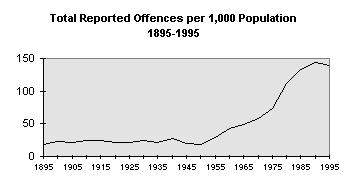
With those increases came increases in criminal violence, and in gun crime. The gun register accordingly gained new significance. However when attempts were made to use the register it was found that this was spread over 16 district offices, in loose paper form, and was very difficult to use. Instructions were given to get it in order on the basis that the work be done when time permitted. Other competing calls on police energies meant that the register continued to deteriorate. A search then took place for some new system which would provide a measure of control within the resources then being made available for such work, as it was considered further resources would not be made available. This resulted in the decision in 1982 to abandon records of firearms and to rely upon a more intensive screening of applicants for firearm licences. Those who passed that test would get lifetime licences and be free to acquire whatever number of firearms they wished.
There were mixed views about the wisdom of relying on controls over licensees and abandoning controls over firearms themselves. But there was little public opposition, and in senior police councils resource arguments, and the belief that any additional funds could be better used for more urgent needs, prevailed. Thus the "licensing but no registration" policy, which is still the basis of our arms control system, was introduced in the Arms Act 1983.
That policy was challenged after the shooting of 13 people at Aramoana by a young man who held a 1983-style licence. His licence entitled him to own as many firearms as he chose, and he used two MSSAs for the purpose. This raised calls for tighter controls. The parliamentary response was the 1992 Amendment Act. It added MSSAs to the list of weapons which had to be registered, revoked the 1983 lifetime licences and required shooters to apply for new ten-year licences, for which they had to pay additional fees. That last provision was considered by many shooters to breach assurances given them during the consultations which preceded the 1983 statute, and their dissatisfaction was one cause of poor compliance with the 1992 Relicensing Project. However the 1992 Amendment did not alter the licensing/no registration basis for arms control which had been introduced in 1983.[Part 2.2]
The Use and Misuse of Firearms in New Zealand
The abandonment of registration of firearms in 1983 persuaded the Police that collecting information about firearms was no longer a necessary part of firearms control. That decision has left no adequate base from which to calculate the number of firearms in this country, let alone the numbers which lie respectively within and without the law. Nor is it possible to achieve close definition of the numbers of shooters, or the volumes of and trends in gun misuse. Similar difficulties have been experienced overseas in countries which do not have close gun controls.
In the result, putting New Zealand into a comparative table is only possible on a "best fit" basis, as both our own and the overseas statistics are weak. However, proceeding on that basis, and applying the results of such surveys and sampling exercises as the Review was able to carry out in the time available, the Review’s conclusions as to the New Zealand situation are as follows.
There are probably between 700,000 and 1,000,000 firearms in New Zealand. On a population basis that puts our rate of gun ownership at about one-third of that in the United States, in the same general rank as Canada and Australia (at least before the latter’s recent ban and buy-back of semi-automatics), and well ahead of the United Kingdom and most European countries.
Gun imports, at between 10,000 and 15,000 per annum, are unlikely to maintain the armoury at that level. Most classes of weapon will reduce in number unless there is a new enthusiasm for guns. The exception is handguns, which have increased in number with the growth in popularity of pistol shooting as a competitive sport.
In the nature of things it is impossible to get an accurate count of the numbers of guns held for criminal purposes. However, there is clear evidence of a substantial pool of illegal guns which is periodically refreshed by purchases, theft and burglary, and (to a lesser extent) by illegal imports. It has been variously estimated at between 10,000 and 25,000, and could be higher, though that seems unlikely. Other findings are that:
Ÿ the favoured weapon for robberies is the sawn-off shotgun;
Ÿ the cheapest illegal guns are shotguns, which have an average price of around $100, whereas pistols usually fetch over $1,000;
Ÿ handguns are used in crime to a greater extent than their proportion of the national armoury; and
Ÿ guns used in domestic violence are mostly owned by the offenders, but guns used for other criminal purposes are generally stolen by the offenders, or acquired from acquaintances and friends and probably stolen. [Part 2.3]
At the conclusion of the present licensing project there are likely to be about 210,000 licensed shooters, a substantial drop from the 327,000 licensed in 1991. Part of the difference represents those who have elected not to re-license. However, continuing reductions in the numbers of applicants for firearm licenses and of game licenses issued, and the continuing urbanisation of society, all point to a downward trend in the numbers of shooters which is not merely temporary. A 1985 estimate anticipated annual increases in the number of firearms licensees of around 3.6 percent. The picture today is rather one of a gradually aging gun-user population which is unlikely to increase in numbers unless recent trends in public attitudes towards firearms are reversed.
The arms code permits the use of guns by unlicensed persons who are "under the immediate supervision" of a licensee. Attempts to determine how many persons do in fact use guns made only modest progress. However, an AGB McNair household survey found that there were 1.8 "users" of each firearm, which suggests that there are 350,000 to 400,000 people using firearms. The same survey found that one in five households has at least one firearm. That figure relates closely to Australian and Canadian estimates. [Part 2.4]
There are some 4,000 firearms offences each year, a level which is higher than was the case prior to 1980, but has not increased over the past six years.
In overall terms firearms play only a small part in inter-personal violence in New Zealand, being used in about 1.7 percent of all violent crime. It is, however, the most serious offences in which firearms are most likely to be used, and the consequences of firearm offending may be particularly grave.
In assessing the significance of present levels of firearm crime it is useful to consider whether its increase has been out of proportion with other violent crime, or has merely followed the general trend. The best available information suggests the latter.
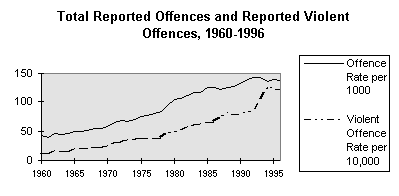
As can be seen on this graph, violent crime rose steeply from 1993 to 1995 during the time when overall offending levelled off. Part of the rise may have been caused by changes in the law and reporting of domestic violence, but once that and other known factors are taken into account, the picture is still one of violent crime rising steeply through to 1991. From 1991 to 1996 there continued to be an increase but at lesser and more uneven rates.
The homicide rate has fallen since 1991, but aggravated robbery is still increasing:
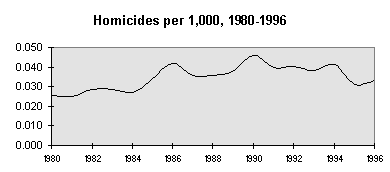
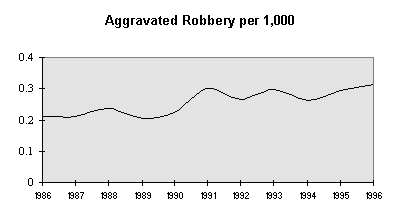
Over the past 15 years firearm crime has increased at a slightly lower rate but generally in sympathy with violence overall. The following graph shows firearm offending remaining a relatively stable proportion of all violence.
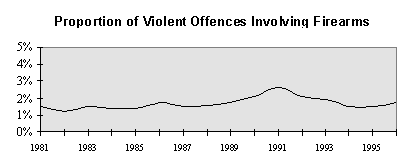
In summary, increases in firearm crime have been less than in all violent crime but have followed its trend sufficiently closely to make it probable that firearm crime is a subset of violent crime, and that violence is leading firearm crime, not the reverse. The level of firearm crime is not increasing in such a way as to suggest a crisis, but it is sufficiently high to give grounds for concern and to require further endeavours to reduce it.
The two recent developments in firearm crime which give particular grounds for concern are the increased numbers of mass shootings, and evidence of increased readiness on the part of criminals to collect guns for use in criminal enterprises.
Although there is a deeply felt public abhorrence of mass killings and a great desire to do something about them, there is no consensus as to their causes, nor as to those measures which are likely to prevent their recurrence. [Part 3.1] The report examines the roles of mental health, and of different types of firearms, especially military style firearms, in mass killings. It concludes that claims that mass killers typically have "a long history of mental health problems and violent behaviour" are not supported by the evidence. Rather, if there is any single characteristic which is common to most mass shooters, it is "social impotence", leading the person concerned to feel isolated from society and to respond with ever more bizarre and aggressive behaviour. [Part 6.1.5]
As to the types of weapons used, these have varied, but the report notes that the use of MSSAs for mass killings, although not a majority use, occurs in a much higher proportion of cases than those firearms have in the total gun population.
While on present information no realistic hope can be held out that action can be taken which will substantially affect the risk of further mass killings, the report does propose steps designed to reduce that risk to some degree. [Parts 6.1.1 and 6.1.5]
Relative Levels of Firearm Crime
In terms of relative levels of firearm crime, our gun crime rate is much less than the United States, but comparable with those in Canada and Australia, the Canadian figures for gun homicide being somewhat higher, probably because of its relatively high handgun population. [Part 3.4]
Gun Suicides
By far the majority of deaths from firearms are suicides. They make up 73 percent of firearms deaths, firearm crime 16 percent, and accidents 9 percent. Recent increases in suicides have given New Zealand one of the highest rates of suicide, and particularly of youth suicide. The increase in gun suicides has been less than the overall increase, but is still at an all-time high. The special hazard of firearm suicide is that firearms are one of the most lethal methods of suicide, ranking in lethality just below hanging. Again there is no clear remedy, but steps proposed to reduce the availability of guns in the home should help. [Part 3.2]
Accidental Deaths and Injuries Involving Firearms
Accidental deaths from firearms have averaged nine per year since 1980, less than 1 percent of total accidental deaths, most of which are motor vehicle fatalities. Although accidental deaths and injuries from firearms had declined over earlier decades, they have shown no consistent increase or decrease in recent years. Lately the rate of accidental deaths in New Zealand has been significantly higher than that in Australia, where the accidental death rate has continued to fall. It is suggested we learn from Australian experience.[Part 3.3]
Degrees of Control of Firearms
A United Nations draft report released last month puts New Zealand towards the middle of the international scale of degrees of control save in the one respect of "a record keeping system for firearms", where our abandonment of that type of control puts us in the minority of countries without such systems. The report also shows that recent changes of attitude in New Zealand certainly do not run ahead of international concerns and desires to achieve closer control over firearms. [Part 4.4]
Submissions to this Review have shown a broadening and intensification of the concerns which had emerged in 1991 about the numbers of guns and the volume of gun crime. This was again expressed most strongly by women and women’s organisations, but was broadly based.
The submissions also showed that there are still strong feelings on both sides of the argument. Most gun owners want to retain the limited restrictions and inexpensiveness of the present system. Most non-shooters express concerns about the level of violence within society and, perceiving firearms to be instrumental in this trend, argue for tighter gun controls. However, in the 1996 submissions, for the first time, a significant number of shooters declared their acceptance of the need to consider further controls. That change of view resembles those which preceded the major reforms of gun laws in Canada (1995) and Australia (1996).
The internal review conducted by the police in May 1996 described the present system as "effective" but in need of some amendment to ensure that it "maintains its high level of integrity".
It was an early and central conclusion by this Review that the present system is fundamentally defective, and that arms control work has suffered from being repeatedly put behind other apparently more urgent police duties. That view was communicated to the Police as early as November 1996. In April 1997 the Police advised that further consideration had convinced them that there was need for a radical change. Later a formal "Police Response" forwarded to the Review on 2 May 1997 confirmed a major shift in the Police position, and that they accepted that the issues which had arisen during the Review, and "international trends in arms compliance", indicated the need for "a different category of control".
Within the last two years Canada, Australia and Great Britain, have all legislated major reforms of their gun control systems, and the United Nations has set up a substantial committee structure dedicated to reducing arms trafficking and improving members’ domestic arms controls.
In part this upsurge in interest has been a reaction to mass shootings, such as Dunblane and Port Arthur. In part it has come from the out-flow of surplus military equipment after the end of the cold war and the breakup of the USSR and the Warsaw Pact armies. Whatever the reason, there can be no doubt that such an upsurge has occurred, or that it shows no sign of abating, or that the signs of a movement towards closer gun controls observable here are at least as apparent in most other Western countries, and in such diverse societies as Germany, India and Japan which, with Australia and Canada, have been leading the charge at the United Nations.
The Way Forward
Standing back from the specific issues it is clear that there is a need for a totally new approach to firearms control. As this has now been accepted by the Police, the issues are the manner and timing of reform, not the need for it.
There are limits to the ability of statutes or regulations to reduce the misuse of firearms. In the long term, promoting responsible attitudes to gun use and ownership will undoubtedly play as important a part in reducing misuse as changing the formal system of gun controls. But a well-designed system can help to encourage responsible attitudes, and to achieve a number of other useful objectives which will ultimately have an effect on firearm misuse. The report proposes a considerable number of reforms designed to further three main objectives:
n
Reducing the number of high-risk licensees;n
Increasing personal responsibility for firearms; andn
Reducing the availability of firearms for misuse.